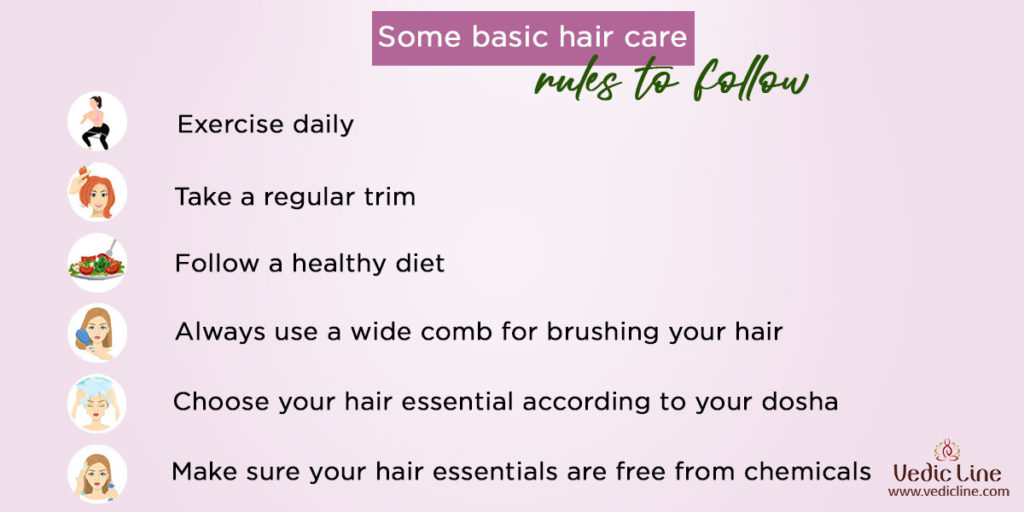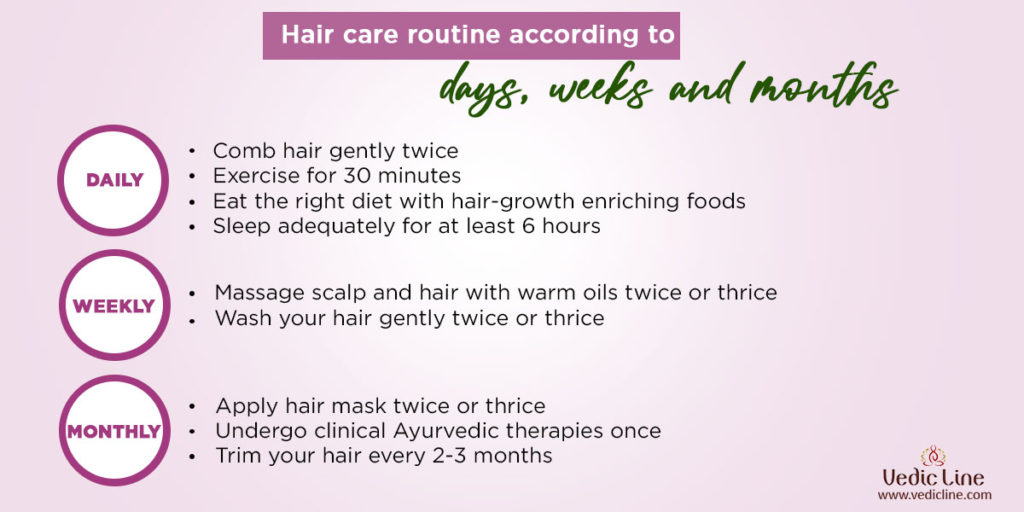Ayurvedic hair care routine for healthy hair

Nowadays, everyone keeps on searching around for hair care tips for men and women.
Do you realize that your undesirable hair is an impression of your awful eating regimen and way of life? Indeed! Conventional Ayurvedic science pushes onto the relationship of hair wellbeing with what you eat and how you live.
However, other than skin medicines with restorative herbs, Ayurveda includes the idea of healthy Ahara-Vihara. Therefore, it benefits the healthy prosperity of your body and psyche alongside your hair wellbeing.
This all-encompassing methodology of Ayurveda requires predictable hair care tips for men & women for solid hair. We should examine what that is and how you can receive it in detail.
Natural hair tips for a healthy hair regimen
1.Know your hair type
As per Ayurveda, the three indispensable energies Vata, Pitta, and Kapha manage our real exercises. Every individual is a mix of these tridoshas, with a couple of doshas in strength. This decides your hair type and hair wellbeing.
A. Vata Hair Type
If you have Vata-prevailing Prakriti, then you will have a Vata hair type. Appropriate herbs to your hair follicles keeps this dosha in balance. A typical Vata hair type will in general be flimsy, straight hair with higher porosity.
At this point, Vata dosha bothers your body, it causes dryness of your scalp and hair with low sebum creation. This in the end brings about dry and frizzy hair, split finishes, and balding.
B. Pitta Hair Type
If you have Pitta prevailing Prakriti then you will have a Pitta hair type. Pitta is liable for metabolic movement in the hair, directing the creation of shades and hair proteins.
A solid Pitta hair will in general be wavy with a medium thickness. Untimely hair greying, scalp irritation, redness, going bald, and so forth are caused when Pitta is imbalanced.
C. Kapha Hair Type
If you have Kapha prevailing Prakriti then you will have a Kapha hair type. Kapha energy is answerable for your hair design and its grease. A healthy Kapha hair is thick, radiant, and wavy.
Any irregularity in Kapha brings about the overproduction of sebum on your scalp. However, in the long run, it prompts sleek dandruff with an oily scalp, tingling, hair fall, and so on.
Understanding your hair type and condition of your dosha levels assists you with Ayurvedic herbs in your hair care schedule. Therefore, it will focus on your one-of-a-kind hair needs.
2. Pick Hair Oil And Shampoo Based On Your Hair Type
Ensure your regular hair items contain Ayurvedic herbs that work on your dosha levels. Picking incorrectly hair items may deteriorate your hair condition and cause awkwardness in your doshas.

Here is the rundown of few dosha-explicit herbs that you can look for in your hair care items:
A. Vata-Pacifying Herbs
Palandu (onion), Gunja (Rosepea), Yashtimadhu (Licorice), Devdar (Cedar), Ashwagandha (Withania Somnifera), Shatavari (Asparagus Racemosus), and so forth
B. Pitta-Pacifying Herbs
Yashtimadhu (Licorice), Japa (Hibiscus), Kamala (Nelumbo Nucifera), Nimba (Neem), Lodhra (Symplocos Racemosa), Karanja (Pongamia Pinnata), and so forth
C. Kapha Pacifying Herbs
Gunja (Rosepea), Grapeseed, Kushta (Saussurea Costus), Methika (Fenugreek), Karpoora (Camphor), Jyotishmathi (Celastrus paniculatus), Daruharidra (Berberis Aristata), and so forth
D. Tridosha Haras
Kumari (Aloe Vera), Brahmi (Bacopa Monnieri), Bhringraj (Eclipta Alba), Amalaki (Indian Gooseberry), Tagara (Valerian root), and so forth
3. Oil Your Hair Regularly
Oiling your scalp and hair is the revival device to remove any overabundance gathered in your mind through marmas.
Other than a revival, hair massage with Ayurvedic oils gives healthy, strong, and shiny hair with their moulding properties of herbs.

Ayurveda suggests oiling your hair 2-3 times each week. You can likewise fix your recurrence of oiling dependent on your hair type.
How to oil your hair
1. Apply warm oil across your scalp.
2. Massage your whole scalp in a roundabout movement utilizing your finger cushions for around 15 minutes.
3. Presently, work some oil from your hair roots to tips by giving a delicate massage.
Roundabout scalp massage animates the blood dissemination and upgrades the oil ingestion into profound layers of your scalp. You can likewise utilize coconut oil, sesame oil, olive oil, and so forth to rub your scalp and hair consistently.
4. Wash Your Hair Regularly
Your scalp follicles get obstructed by the undesirable development of oils, soil, and grime. However, you need to purge out through ordinary hair wash with Ayurvedic shampoos.
Other than Ayurvedic shampoos that are explicit to your dosha, you can likewise choose common hair purging herbs.
Ayurveda suggests you wash your hair twice or threefold in seven days.
5. Condition Your Hair Regularly With Hair Masks
Ayurveda proposes applying hair covers once a week or fortnight to keep your scalp and hair healthy. Additionally, it assists you with combatting inner balding variables like pressure and uneasiness.
You can utilize Ayurvedic home products like Amalaki, henna, fenugreek, aloe vera gel, and so forth. Apply the mask from your underlying foundations to hair tips and leave it for around 30-40 minutes.
6. Figure out How To Comb
Brushing is one of the successful approaches to upgrade blood course on your scalp. It helps in detangling your hair and spreading your scalp’s normal oils equally over your hair strands. Yet, energetic brushing can harm your hair by extending it and this may prompt hair breakage and split finishes.

Ayurveda proposes you brush your hair on more than one occasion delicately utilizing a wooden obtuse toothed brush. Additionally, wash your brush consistently to keep away from soil amassing, and don’t impart your brush to other people.
7. Trim Your Hair Regularly
Broken hair with split finishes gives a slight and unpleasant look to your hair tips. You can stay away from this by disposing of split finishes through normal management. Guarantee you take out your split finishes by managing your hair each 8-12 weeks.
8. Stay away from Chemical Products
The brutal synthetics utilized in hair items may change your scalp pH. However, they can peel off the common oils from your scalp and protein layers from your hair. Change to Ayurvedic items with regular home grown fixings to achieve comprehensive hair wellbeing without undesirable dangers.
9. Stay away from Heat Styling
Use of heat styling devices like blow-dryers or hair curlers, and so forth leave your hair dampness less after some time. It shoots up Vata dosha causing dryness, breakage, split finishes, and hair fall. It is smarter to leave your hair for air drying after your hair wash.
10. Shield Your Hair From Harsh Environment
Ecological contamination and UV radiation harm your hair follicles by altering your scalp’s regular oils. It additionally makes your hair weak and dull. What’s more, exorbitant admission of liquor and cigarettes may deteriorate your condition causing extreme balding.
Ensure you wear a cap or scarf to secure your hair when you head outside or swim in chlorinated water. Keep away from the utilization of cigarettes and liquor for better hair wellbeing. This is one of the basic hair care tips for men & women.
Ayurveda proposes applying oil before going under the sun as it goes as a defensive layer to your scalp.
The Last Word
Ayurveda is the lifestyle to stay adjusted and lively by adjusting our real rhythms to the rhythms of nature. This is accomplished through the standard which suits your hair type while you can achieve outstanding hair wellbeing. At Vedicline, we define an Ayurvedic hair care routine to treat your hair fall by assessing your dosha levels. In this blog, vedicline briefly defines hair care tips for men and women both with natural products.
